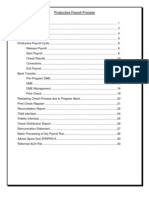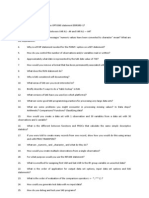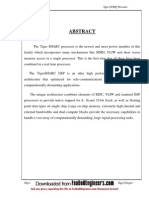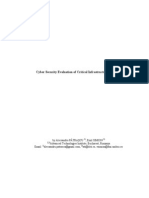SAP HR and Payroll - Expanding Schemas and Rules
SAP HR and Payroll - Expanding Schemas and Rules
Uploaded by
Bharathk KldCopyright:
Available Formats
SAP HR and Payroll - Expanding Schemas and Rules
SAP HR and Payroll - Expanding Schemas and Rules
Uploaded by
Bharathk KldCopyright
Available Formats
Share this document
Did you find this document useful?
Is this content inappropriate?
Copyright:
Available Formats
SAP HR and Payroll - Expanding Schemas and Rules
SAP HR and Payroll - Expanding Schemas and Rules
Uploaded by
Bharathk KldCopyright:
Available Formats
Home
Home If your browser does not support the SDS Knowledge Base menu, click here for an alternative.
Services & Products
Human Resources
Knowledgebase
About SDS
Customers & Partners
Links
Sitemap
Knowledgebase
Payroll / Personnel T ime Management
Expanding Schemas & Rules
Search Q
SAP HR Schemas and Rules: Expanding Within a Main Time or Payroll Schema
Your Input Purpose and use
There are two main ways to expand a Payroll or Time Schema and each has advantages and disadvantages over the other. One is to run the programs for at least one individual with the Log Display option selected. The other is through transaction RPDASC00 which allows for the option of exploding the s chemas down as far as individual s teps within a PCR. Expanding or exploding a s chema can be extremely useful in route-causing issues or locating configuration which may need to be copied or maintained.
Query Tools Data Tools Human Resources FI/CO Cross System Miscellaneous BW
We are always up our articles and a new ones to the li Please let us kno is a particular arti would like to see.
Application
RPDASC00 The main difference with Displaying the Log of a payroll or time processing, is that RPDASC00 explod es the entire schema (to whatever level is chosen) not just the part relevant to a particular employee. This is particularly useful in locating such things as wagetypes and PCRs which will not neces sarily have been processed. Layout also differs being more the traditional table view format rather than the tree view format presented by the Dis play Log. However, s ince this is an expansion of the whole schema, there is exact reference to line numbe rs and sub schemas (excluding any lines which have been commented out), making location and editing of a particular point within the schema easier. If the options are selected such that all s chemas and calculation rules are expanded, a search for (e.g.) a particular wagetype will return every possible occurrence of that wagetype within the schema. This allows tracking of every stage of processing and may help to reveal errors in PCRs, configuration which can be duplicated and modified, etc. The disadvantage of this way of expanding the s chemas is that any wagetypes which are not process ed within the schema but are just read in and pos ted to a table, to the RT for instance, will not be found. Display Log When running both Time and Payroll schemas either in real or simulation, there is an option to Displ ay [the] Log. If this option is not selected but the schema encounters an error which prevents proces s completion, a partially expanded s chema (down to the error point) will be displayed. If the s chema executes s uccess fully, th ere will be no Log displayed. With the Display Log s elected and the program executed, the respective schema is displayed for the employee(s) being processed. In this instance the s chema displayed may not be the entire schema. Only those s ections which have been processed in relation to the employee(s) selected are shown. This is a distinct advantage when traci ng, for example, a wagetype through the s chema to as certain how its value in the RT relates to its initial value, or wh y it has not been processed or output. The other major benefit of this way of expanding the s chema is that actual data and meaningful values can be followed through making errors easier to identify than when using the exploded s chema view via RPDASC00. Since the expanded views of PCRs show only those steps through which any one employee has been s ent, errors in calculation (particularly if s teps within a PCR are printed out) can very eas ily be identified. The disadvantage of expanding the schema in this way is that any wagetypes which are hardcoded into PCRs as ass ignment wagetypes and then written straight out to the RT without any further processing, will not be found on searching. They may be located in the RT but it is more difficult to as certain how their value was derived. This Schema is expanded within a tree view which shows clearly the relationship of processing steps to the various parts of the schema (Gross Payments, Loans, Benefits etc). The main immediate difference between payroll and time schemas at this stage is the at the former displays by payroll period and the latter by day.
Copyright 2009 Strategic Data Solutions Ltd. All rights reserved
You might also like
- Sap HR PCR Time MGTDocument14 pagesSap HR PCR Time MGTHarris CHNo ratings yet
- Interview Questions Sap HRDocument15 pagesInterview Questions Sap HRశ్రీకాంత్ కొంతంNo ratings yet
- SAP HR Schemas and RulesDocument12 pagesSAP HR Schemas and RulesKumar Ranjan100% (6)
- Free Sex ChatDocument3 pagesFree Sex ChatCarlsenBengtson4250% (4)
- Personnel Calculation Rule and Schema - An UnderstandingDocument14 pagesPersonnel Calculation Rule and Schema - An UnderstandingBharathk KldNo ratings yet
- SAP-HR Mydoc 2Document15 pagesSAP-HR Mydoc 2Rajiv KumarNo ratings yet
- Debugging The Payroll SchemaDocument28 pagesDebugging The Payroll SchemaRoberto MartínezNo ratings yet
- Personnel ActionsDocument20 pagesPersonnel Actionstauras100% (2)
- SAP Ad-Hoc QueryDocument2 pagesSAP Ad-Hoc QueryLee VoyNo ratings yet
- SAP HCM Part 2Document7 pagesSAP HCM Part 2RajaNo ratings yet
- Fdocuments - in - Sap HCM Om PresentationDocument135 pagesFdocuments - in - Sap HCM Om PresentationVaishnavi MakamNo ratings yet
- SAP SuccessFactors Employee Central Integration With SAP SuccessFactors Employee Central PayrollDocument95 pagesSAP SuccessFactors Employee Central Integration With SAP SuccessFactors Employee Central PayrollsaidNo ratings yet
- Absence Quota Generation StepsDocument27 pagesAbsence Quota Generation StepsAshok Kancharla100% (2)
- Instructor Guide40 - HR311 - Time Eval Without Clock TimesDocument37 pagesInstructor Guide40 - HR311 - Time Eval Without Clock TimesRogério Andrade Dos Santos100% (1)
- SAP HR and Payroll - Time Management DataDocument2 pagesSAP HR and Payroll - Time Management DataBharathk KldNo ratings yet
- How To Assign Counting Rules To Absence Types in SAPDocument4 pagesHow To Assign Counting Rules To Absence Types in SAPnuta24No ratings yet
- BBP Questionnaire For RSCL - HCMDocument6 pagesBBP Questionnaire For RSCL - HCMnarayanaNo ratings yet
- Procedure For Uploading Employee Photos Into SAPDocument5 pagesProcedure For Uploading Employee Photos Into SAPparthascNo ratings yet
- Internal Tables For PayrollDocument19 pagesInternal Tables For PayrollJoe CuervoNo ratings yet
- Time SenariosDocument39 pagesTime SenariostvspreddyNo ratings yet
- TM04 Schema in DetailDocument6 pagesTM04 Schema in DetailSrikanth Reddy100% (2)
- TM Timemanagementconfiguration 150327190854 Conversion Gate01Document8 pagesTM Timemanagementconfiguration 150327190854 Conversion Gate01Carmen DiacNo ratings yet
- Organizational Management Training Manual - en V1.0Document28 pagesOrganizational Management Training Manual - en V1.0Aditya DeshpandeNo ratings yet
- What Steps Are Required To Configure To Create Wage Type in Sap PayrollDocument20 pagesWhat Steps Are Required To Configure To Create Wage Type in Sap Payrollnuta24100% (1)
- SuccessFactors Job Profile Builder Side Effect ..Document2 pagesSuccessFactors Job Profile Builder Side Effect ..abhilashNo ratings yet
- KSA - GOSI Enhancements Overview + SettingsDocument6 pagesKSA - GOSI Enhancements Overview + SettingssriNo ratings yet
- Work Schedules in SAP HRDocument8 pagesWork Schedules in SAP HRShiva Kiran VaddiparthiNo ratings yet
- Schema Sap HRDocument3 pagesSchema Sap HRzafer nadeem100% (3)
- Understanding Absence QuotasDocument31 pagesUnderstanding Absence QuotasHan Maryani100% (2)
- 7 - SAP HCM - Company LoansDocument11 pages7 - SAP HCM - Company Loanscjherrera2No ratings yet
- Indirect Evaluation (INVAL) and 40ECS Feature: PurposeDocument6 pagesIndirect Evaluation (INVAL) and 40ECS Feature: PurposeTejaswi ReddyNo ratings yet
- Generate Time Wage Types by Configuring Table T510SDocument8 pagesGenerate Time Wage Types by Configuring Table T510SSai Shilpa Teju100% (2)
- An SAP Consultant - SAP HR Payroll ClustersDocument7 pagesAn SAP Consultant - SAP HR Payroll ClustersarunNo ratings yet
- SAP HR Authorizations 1Document30 pagesSAP HR Authorizations 1Manimala Arumugam100% (1)
- SAP Certified Application Associate - SAP HCM Payroll With ERP 6.0 EHP7Document2 pagesSAP Certified Application Associate - SAP HCM Payroll With ERP 6.0 EHP7karamananNo ratings yet
- HR Organizational Management ConfigurationDocument54 pagesHR Organizational Management ConfigurationKhagendra SinghNo ratings yet
- Abap HR Document PDFDocument83 pagesAbap HR Document PDFDavid Pieschacon RuedaNo ratings yet
- 1809 Take HCM To The Cloud With Employee Central PDFDocument34 pages1809 Take HCM To The Cloud With Employee Central PDFrameshjakkula100% (2)
- SAP Income TaxDocument5 pagesSAP Income TaxBullet BairagiNo ratings yet
- Sap HCM HR Reports CodeDocument7 pagesSap HCM HR Reports Codesatishalluri100% (1)
- EC To ECP DocumentDocument18 pagesEC To ECP DocumentVaibhav VashisthaNo ratings yet
- Subsequent Activities in SAP HR PayrollDocument7 pagesSubsequent Activities in SAP HR Payrollclaoker100% (1)
- Dynamic Actions - Multiple ScenariosDocument7 pagesDynamic Actions - Multiple ScenariosSuresh Kumar100% (1)
- Sap - Whats New S4hana HCM 1809 2023Document107 pagesSap - Whats New S4hana HCM 1809 2023crisdefreitasNo ratings yet
- Control RecordsDocument32 pagesControl RecordsBharathk KldNo ratings yet
- Configuring SAP HR Payroll Settings For Retroactive AccountingDocument1 pageConfiguring SAP HR Payroll Settings For Retroactive Accountingravibabu1620100% (1)
- Example Relating To PostingsDocument5 pagesExample Relating To Postingsravibabu1620No ratings yet
- Retroactive Accounting PDFDocument16 pagesRetroactive Accounting PDFMohamed Shanab100% (3)
- Productive PayrollDocument33 pagesProductive Payrollramyameena321No ratings yet
- Sap HR - Question AnswerDocument35 pagesSap HR - Question Answersumitvfx87100% (3)
- Workday Financial Performance Management Complete Self-Assessment GuideFrom EverandWorkday Financial Performance Management Complete Self-Assessment GuideNo ratings yet
- Dif 3.xx Ate 6.0 Ehp4Document603 pagesDif 3.xx Ate 6.0 Ehp4Marco EndresNo ratings yet
- SAS Interview Q and ADocument5 pagesSAS Interview Q and Akiran3114No ratings yet
- How Can A Planning Version Be Frozen and UnfrozenDocument4 pagesHow Can A Planning Version Be Frozen and UnfrozenhariNo ratings yet
- SAS Technical Interview QuestionsDocument4 pagesSAS Technical Interview QuestionsRahul PatelNo ratings yet
- Basic SAS Interview QuestionsDocument71 pagesBasic SAS Interview Questionsdinesh441981No ratings yet
- Sap Basis ActivitiesDocument129 pagesSap Basis ActivitiesOscar Zambrano CNo ratings yet
- SAPActivate Methodology 2Document1 pageSAPActivate Methodology 2Bharathk KldNo ratings yet
- SAP SD Training Table of ContentsDocument12 pagesSAP SD Training Table of ContentsBharathk KldNo ratings yet
- Sap SD PPT-1Document47 pagesSap SD PPT-1vijaykumarNo ratings yet
- Control RecordsDocument32 pagesControl RecordsBharathk KldNo ratings yet
- Number Range Does Not Exist 2012 11Document4 pagesNumber Range Does Not Exist 2012 11Bharathk KldNo ratings yet
- Sap Implemented CompaniesDocument6 pagesSap Implemented CompaniesBharathk Kld50% (2)
- SAP SD BillingDocument37 pagesSAP SD BillingRam Mani100% (2)
- Sap Implemented CompaniesDocument6 pagesSap Implemented CompaniesBharathk Kld50% (2)
- No Schedule Lines Due ToDocument15 pagesNo Schedule Lines Due ToBharathk KldNo ratings yet
- No Pricing Procedure Couldbe DeterminedDocument4 pagesNo Pricing Procedure Couldbe DeterminedBharathk KldNo ratings yet
- Header Condition and Group Condition: What Are Header Conditions?Document2 pagesHeader Condition and Group Condition: What Are Header Conditions?Bharathk KldNo ratings yet
- What Is Sap?: What's in It For Me ?Document4 pagesWhat Is Sap?: What's in It For Me ?Bharathk KldNo ratings yet
- MMPV Error in Posting PeriodsDocument5 pagesMMPV Error in Posting PeriodsBharathk KldNo ratings yet
- 5.cust MTRL Info RecordDocument5 pages5.cust MTRL Info RecordBharathk KldNo ratings yet
- 3rd Week Training SessionDocument114 pages3rd Week Training SessionBharathk KldNo ratings yet
- 3.sap SD Enter StructureDocument18 pages3.sap SD Enter StructureBharathk Kld100% (1)
- UNIT 1 Technical Comm. Sem 3 B.Tech.Document9 pagesUNIT 1 Technical Comm. Sem 3 B.Tech.upadhyaydevansh55No ratings yet
- Resume RaghuDocument4 pagesResume Raghuapi-323665118No ratings yet
- Component e 45589Document32 pagesComponent e 45589galvangrrNo ratings yet
- Test Automation Using Selenium Web Driver Java PreviewDocument44 pagesTest Automation Using Selenium Web Driver Java PreviewAnil KumarNo ratings yet
- SDE Template SharathDocument2 pagesSDE Template SharathLIVAN KUMARNo ratings yet
- Tps Can Ban Can San TPSSERI DHDocument18 pagesTps Can Ban Can San TPSSERI DHdaocongdablNo ratings yet
- NDOT ABT PresentationDocument27 pagesNDOT ABT PresentationThuy VuNo ratings yet
- Service Guide: Canon U.S.A., Inc. Rev. 0 Technical Support Division March 1999Document41 pagesService Guide: Canon U.S.A., Inc. Rev. 0 Technical Support Division March 1999COPIMASE COPIADORAS MATERIALES Y SERVICIOSNo ratings yet
- The American Association (AHA)Document14 pagesThe American Association (AHA)syedNo ratings yet
- Free MindsDocument31 pagesFree MindsAndrea GiottiNo ratings yet
- Machine Learning Classification of Normal vs. Age-Related Macular Degeneration OCT ImagesDocument5 pagesMachine Learning Classification of Normal vs. Age-Related Macular Degeneration OCT ImagesBOHR International Journal of Smart Computing and Information TechnologyNo ratings yet
- Auto CorrectionDocument13 pagesAuto CorrectionpavanbhatNo ratings yet
- LESSON 4 Assignment MethodDocument4 pagesLESSON 4 Assignment MethodDENZ RAYMOND LACUESTANo ratings yet
- Databases Exercise Sheet +Document5 pagesDatabases Exercise Sheet +ebosdtNo ratings yet
- A Systematic Review of Immersive Technologies For Education: Effects of Cognitive Load and Curiosity State On Learning PerformanceDocument34 pagesA Systematic Review of Immersive Technologies For Education: Effects of Cognitive Load and Curiosity State On Learning Performancejhonnydm93No ratings yet
- Section 66E. Punishment For Violation of Privacy.-Whoever, Intentionally or KnowinglyDocument7 pagesSection 66E. Punishment For Violation of Privacy.-Whoever, Intentionally or KnowinglyDanielNo ratings yet
- How To Write A Master's Thesis in Computer ScienceDocument6 pagesHow To Write A Master's Thesis in Computer ScienceCowboysOfDallasNo ratings yet
- Introduction To The Parareal AlgorithmDocument93 pagesIntroduction To The Parareal AlgorithmTina BargoNo ratings yet
- Tiger SHARC ProcessorDocument35 pagesTiger SHARC ProcessorSurangma ParasharNo ratings yet
- Microsoft Excel TutorialDocument90 pagesMicrosoft Excel Tutorialteacher.lexleo2782100% (1)
- Dell's Working Capital CaseDocument3 pagesDell's Working Capital CaseRonak KamdarNo ratings yet
- Sonia's ResumeDocument1 pageSonia's ResumeDivya SoodNo ratings yet
- Tab 2 A1070Document82 pagesTab 2 A1070moha mohNo ratings yet
- 17 - Chapter 9 PDFDocument5 pages17 - Chapter 9 PDFما هذا الهراءNo ratings yet
- Precision Rectifier CircuitsDocument13 pagesPrecision Rectifier CircuitsWaqas PervaizNo ratings yet
- Htmlburger Web Design ProposalDocument12 pagesHtmlburger Web Design Proposalevilleta_1No ratings yet
- Automotive Cyber SecurityDocument27 pagesAutomotive Cyber SecurityBizon CristiNo ratings yet
- Template Human Resource ManagementDocument7 pagesTemplate Human Resource ManagementMay AbiaNo ratings yet
- In Partial Fulfillment For The Requirement of The Subject Criminology7Document55 pagesIn Partial Fulfillment For The Requirement of The Subject Criminology7kim ryan uchiNo ratings yet







































































































